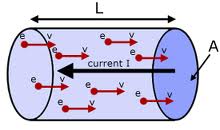
Back سرعة انجرافية Arabic Dreyf sürəti Azerbaijani তাড়ন বেগ Bengali/Bangla Velocitat de deriva Catalan Driftová rychlost Czech Driftgeschwindigkeit German Velocidad de deriva Spanish سرعت رانش Persian Vaellusnopeus Finnish Vitesse de dérive (électricité) French
In physics, drift velocity is the average velocity attained by charged particles, such as electrons, in a material due to an electric field. In general, an electron in a conductor will propagate randomly at the Fermi velocity, resulting in an average velocity of zero. Applying an electric field adds to this random motion a small net flow in one direction; this is the drift.

Drift velocity is proportional to current. In a resistive material, it is also proportional to the magnitude of an external electric field. Thus Ohm's law can be explained in terms of drift velocity. The law's most elementary expression is:
where u is drift velocity, μ is the material's electron mobility, and E is the electric field. In the MKS system, drift velocity has units of m/s, electron mobility, m2/(V·s), and electric field, V/m.
When a potential difference is applied across a conductor, free electrons gain velocity in the direction, opposite to the electric field between successive collisions (and lose velocity when traveling in the direction of the field), thus acquiring a velocity component in that direction in addition to its random thermal velocity. As a result, there is a definite small drift velocity of electrons, which is superimposed on the random motion of free electrons. Due to this drift velocity, there is a net flow of electrons opposite to the direction of the field. The drift speed of electrons is generally in the order of 10-3 meters per second whereas the thermal speed is on the order of 106 meters per second.
© MMXXIII Rich X Search. We shall prevail. All rights reserved. Rich X Search
